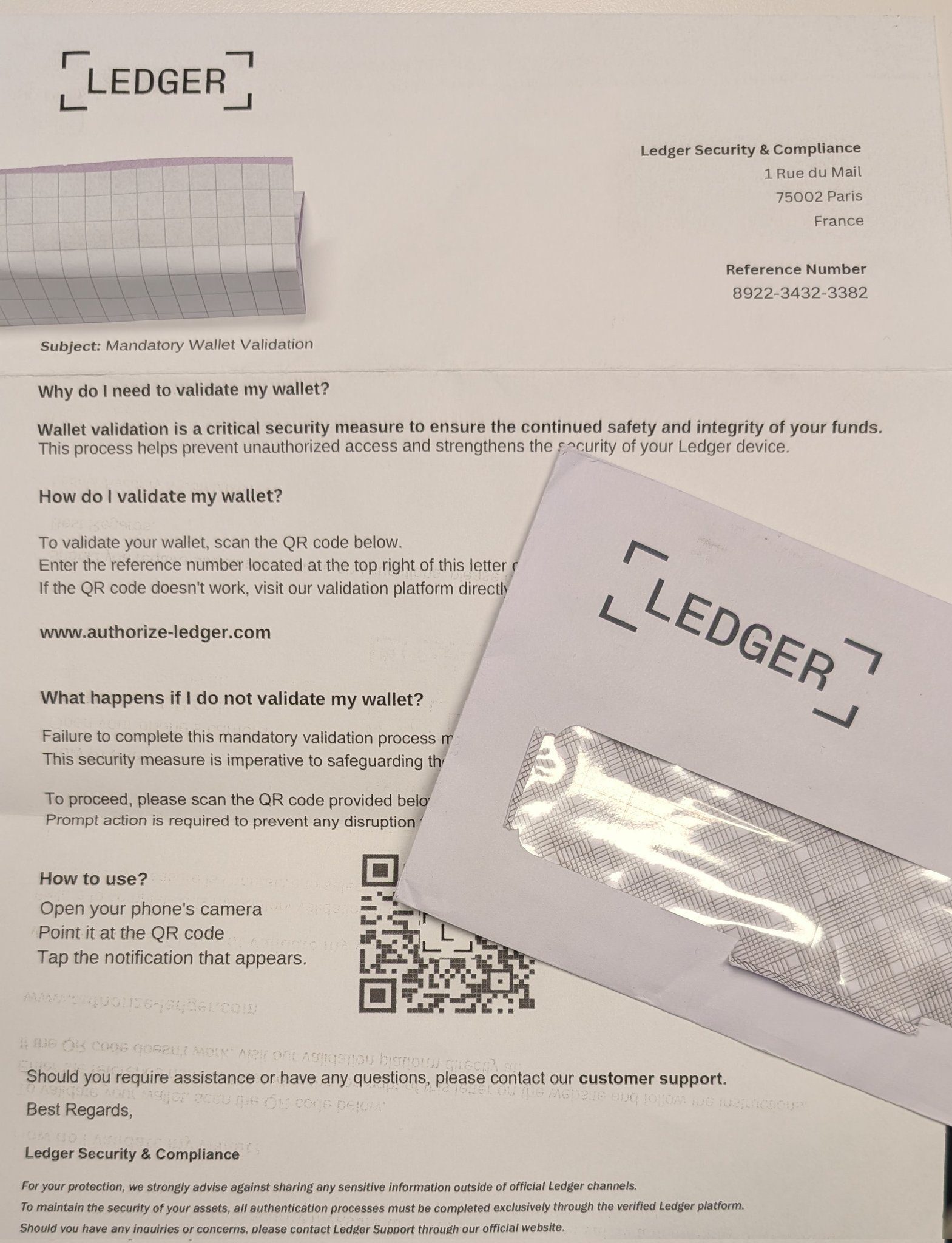A new wave of phishing attacks is targeting Ledger hardware wallet users through physical letters delivered by the United States Postal Service (USPS). These letters, designed to mimic official Ledger communications, instruct recipients to “validate” their wallets, creating a sense of urgency that can lead to compromised crypto assets. This article delves into the details of the scam, provides actionable steps to protect yourself, and highlights similar recent phishing incidents in the crypto space.
The Ledger Phishing Letter: What to Look For
The scam letter typically contains a QR code that directs users to a malicious website designed to steal their private keys or seed phrases. These websites often closely resemble the official Ledger website, making it difficult for even experienced users to distinguish the fraud. BitGo CEO Mike Belshe shared an example of the letter on social media, raising awareness of the growing threat.

Key indicators of the phishing letter include:
- Unsolicited Arrival: Legitimate Ledger communications are typically digital. Be suspicious of unexpected physical letters.
- Urgent Language: The letter will likely use language that creates a sense of urgency or fear, pressuring you to act quickly.
- QR Code or Link: Be extremely cautious of QR codes or links directing you to a website. Manually type the official Ledger website address (ledger.com) into your browser instead.
- Poor Grammar or Spelling: Phishing attempts often contain grammatical errors or typos.
How to Protect Yourself from Ledger Phishing Scams
Protecting your crypto assets requires vigilance and a proactive approach. Here’s how to stay safe:
- Never Share Your Seed Phrase: Ledger, or any legitimate crypto service, will never ask for your 24-word seed phrase. This is your ultimate key to your crypto, and it should be kept completely offline and secure.
- Verify Website URLs: Always double-check the website address in your browser’s address bar. Ensure it’s the correct Ledger domain (ledger.com) and that there’s a padlock icon indicating a secure (HTTPS) connection.
- Enable Two-Factor Authentication (2FA): Use 2FA on all your crypto accounts for an extra layer of security.
- Be Wary of All Communications: Treat any unsolicited communication with suspicion, whether it’s an email, letter, or phone call.
- Report Suspicious Activity: If you receive a suspicious letter or email, report it to Ledger and relevant authorities.
- Use a Hardware Wallet Securely: Understand how your Ledger hardware wallet works and follow best practices for secure usage.
Recent Phishing Attacks in the Crypto Space
The Ledger phishing scam is just one example of the increasing sophistication of crypto-related phishing attacks. In April 2025, a large amount of Bitcoin was stolen from an elderly individual through a social engineering attack. Cybercriminals are constantly developing new tactics to exploit vulnerabilities and steal crypto assets. Other examples include:
- Fake Ledger Live Apps: Hackers have created fake versions of the Ledger Live app to steal seed phrases.
- Coinbase Ransom Attempt: Customer service contractors leaked user data, leading to a ransom demand.
- Address Poisoning: Scammers send small amounts of cryptocurrency to numerous addresses. When users copy-paste their address, they might accidentally select the scammer’s address from their history, effectively sending funds to the attacker.
These incidents highlight the need for continuous education and awareness within the crypto community.
Understanding Social Engineering
Social engineering is a key tactic used in many phishing scams. It involves manipulating individuals into divulging sensitive information or performing actions that compromise their security. Scammers often use tactics such as:
- Creating a Sense of Urgency: Pressuring victims to act quickly without thinking.
- Impersonating Authority: Pretending to be a representative of a trusted organization like Ledger or Coinbase.
- Exploiting Fear: Threatening victims with negative consequences if they don’t comply.
By understanding these tactics, you can better recognize and avoid social engineering attacks.
Conclusion
The Ledger phishing letter serves as a stark reminder of the ongoing threats in the crypto space. By staying informed, practicing good security hygiene, and remaining vigilant, you can significantly reduce your risk of becoming a victim of these scams. Always remember to protect your seed phrase, verify website URLs, and be wary of any unsolicited communications. The security of your crypto assets ultimately rests in your hands.